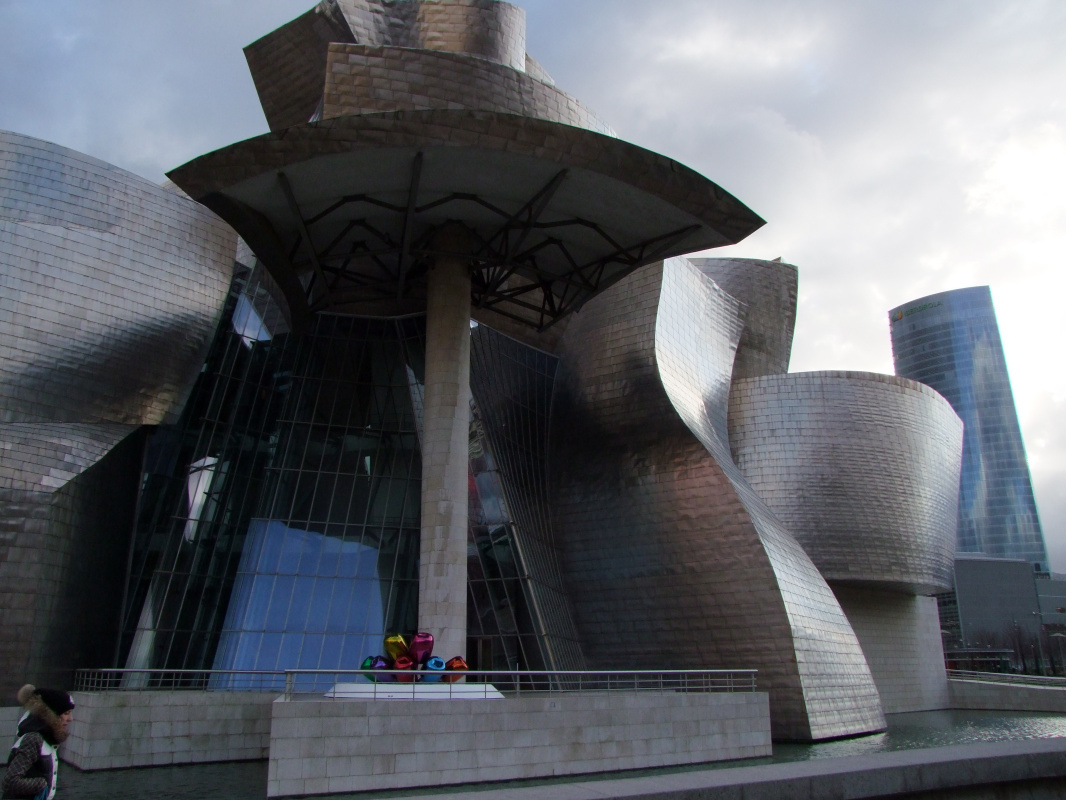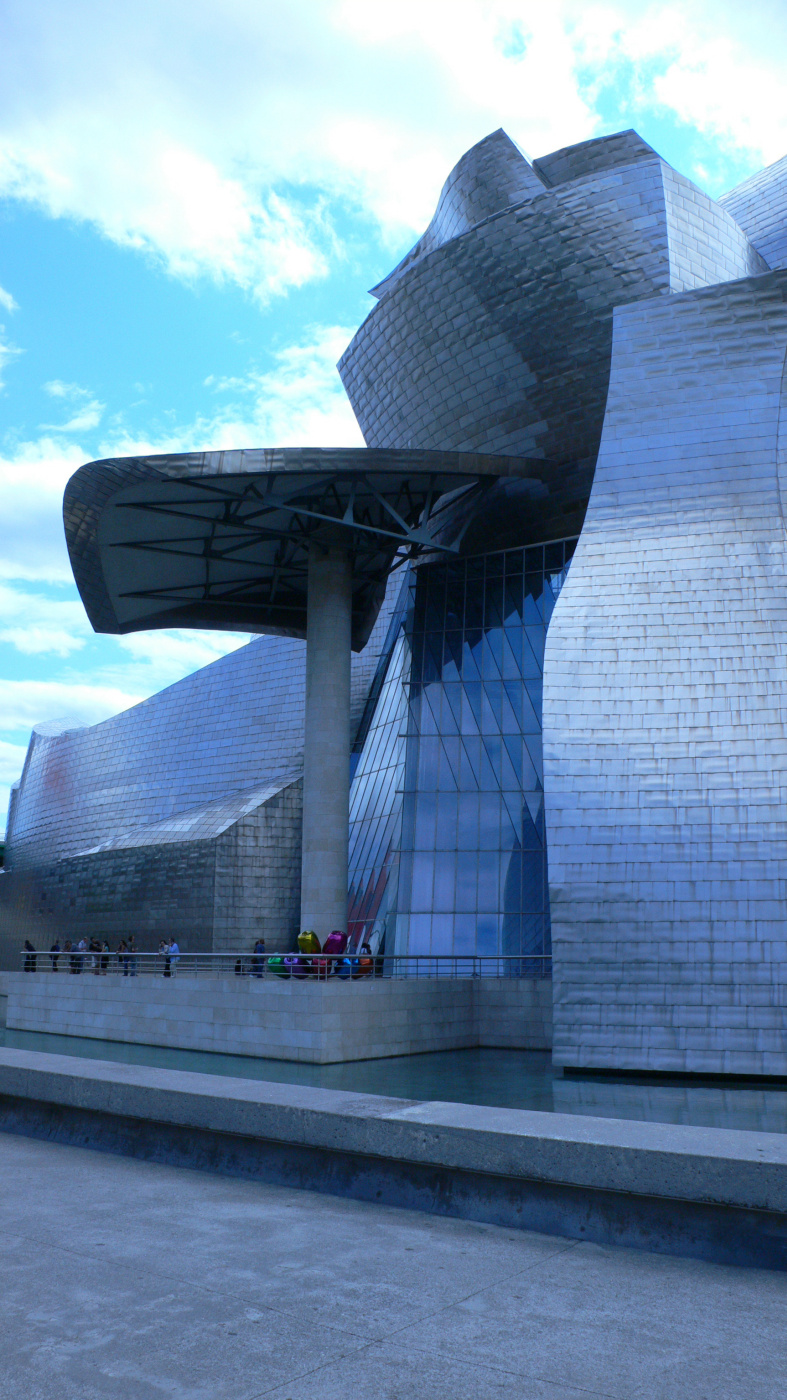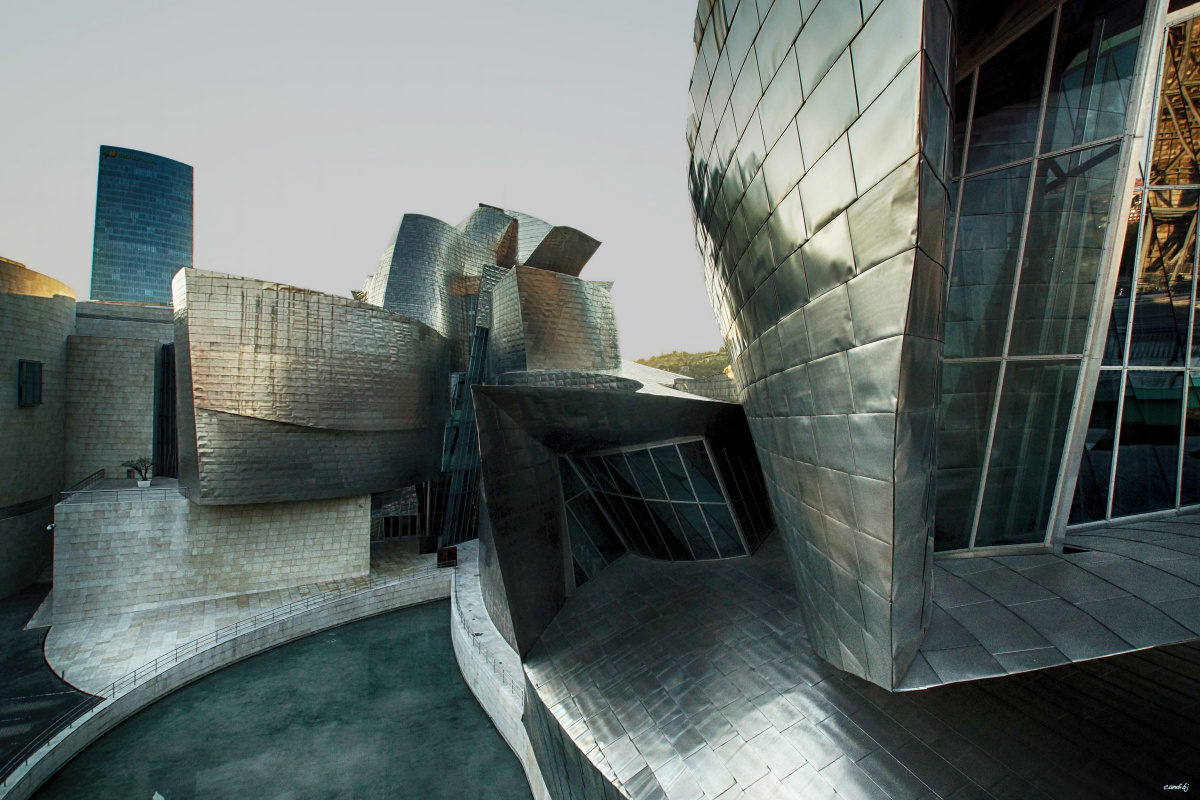log in
Enter site
Login to use Arthive functionality to the maximum
Guggenheim Museum Bilbao
Frank Owen Gehry • Architecture, 1997
Description of the artwork «Guggenheim Museum Bilbao»
The Guggenheim Museum in Bilbao, located on the banks of the Nervión River in the Basque Country (Spain), is a mixture of complex vortex forms and captivating materiality, which corresponds to the industrial urban context. The facility, designed by Frank Gehry, not only changed the views of architects and visitors to museums, but also contributed to the growth of Bilbao's economy. The phenomenon of the transformation of the city after the construction of a significant architectural object is now called the “Bilbao effect”. In the 2010 World Architecture Review, experts called the museum one of the most important structures erected since 1980.
Story
In 1991, the Basque government proposed to the Solomon R. Guggenheim Foundation to establish a museum in the old port of Bilbao, which was once the main source of income for the city. The Spaniards agreed to cover construction costs, create a fund for acquisitions, and subsidize the institution’s annual budget. In turn, the Fund undertook to manage the museum, rotate permanent collections between branches and organize temporary exhibitions.
The Guggenheim Foundation chose Frank Gehry as the architect, and Thomas Krens, director of the organization, invited him to create something bold and innovative. The curvature of the facade of the building should have seemed random - the developer said that it was necessary "to catch the light." The interior is built around a large atrium filled with light overlooking the river and the surrounding hills of the Basque Country. Because of its shape, it is called the “Flower”.
The museum was opened with fanfare on October 18, 1997 with the participation of the King of Spain, Juan Carlos I. The building was immediately named “One of the most impressive deconstructivist buildings in the world” (although Geri does not associate himself with this architectural movement) and a masterpiece of the 20th century. Architect Philip Johnson Named Museum "The greatest building of our time"and critic Kelvin Tomkins in The New Yorker described "A fantastic, wave-shaped dream ship in a cloak of titanium". The New York Times Magazine noted the “mercury shine” of the surface, and the Independent newspaper called the creation of Gehry "Amazing architectural feat".
The museum organically fits into the urban context, unfolding its interlocking forms of stone, glass and titanium in the old industrial center of the city. From the side of the street, the building looks modest, its most impressive view opens from the river. The exhibition area is divided into 19 galleries, ten of which follow the classic orthogonal plan - they can be identified on the facade by stone trim. The remaining nine are irregular in shape and can be identified externally by swirling organic forms and a titanium sheath. The largest gallery is 30 meters wide and 130 meters long. Since 2005, there has been a permanent installation of Richard Serra's monumental installation, The Essence of Time.
The building was built on time and budget, which rarely happens in this type of architecture. Gehry explained this by the fact that, firstly, he minimized "Interference of political and business interests in design"secondly, he made sure that he had a detailed and realistic estimate of expenses, and thirdly, he used computer visualization based on CATIA software.
Foundation and coating
The museum is a colossal structure, which required more than 25 thousand tons of concrete (10 thousand cubic meters), and therefore requires a deep and solid foundation. It was laid on 665 reinforced concrete piles driven into a rock to an average depth of 14 meters.
The base of the building is covered with beige limestone quarried in quarries near Granada. The walls are specially treated to protect the interior from sun exposure. Window panes also prevent direct rays from entering the exhibits.
The building is lined with 33 thousand titanium plates, covering each other like scales. This material replaced toxic copper and lead - many tests passed before its use, until an alloy was found that can withstand heat and bad weather, while retaining its properties. Parts were manufactured in Pittsburgh (USA), where rolling made it possible to obtain titanium plates with a thickness of only 0.4 mm - much thinner than steel. Moreover, titanium is half lighter than steel, so the entire titanium coating of the museum weighs only about 60 tons.
Titanium is an environmentally friendly material, and each fragment received its own design depending on its orientation on the building, so everything perfectly matches the curves that Frank Gehry conceived.
The Bilbao Effect and criticism
The social and economic influence of the museum was striking. In the first three years of work, it was visited by about 4 million tourists, which brought about 500 million profit. Moreover, more than 100 million taxes were collected from the money that visitors spent in hotels, restaurants, shops and transport, which offset the cost of building the building. However, the expectation of the “Bilbao effect” provoked a construction boom in a similar style throughout the world, which turned out to be unwise in light of the recent economic crisis.
The Bilbao Effect characterizes how the museum transformed the city. However, the same term was used by critics, who called it a symbol of "refinement" and "cultural imperialism." The Wall Street Journal proposed renaming the “Bilbao effect” to “Bilbao anomaly”, explaining that “Cult chemistry between the design of a building, its embodiment and society is extremely rare”.
Architect critic Paul Goldberger, Pulitzer Prize winner, shares the view that Guggenheim is in Bilbao “Could not be built without CATIA” and “Was the first building where this software played a role in almost all aspects of design and construction”.
Art critic Brian O'Doherty was positive about the appearance of the building, but criticized the interior of the museum, saying: “When you get into the room, everything changes somewhat. Even the so-called “work for a particular place” looked out of place. Most interior spaces are too vast. ”. He further described how the works of Georges Braque, Pablo Picasso and Alexander Rodchenko looked “absurd” and “lonely” on the walls of the museum.
See also: Guggenheim Museum Bilbao Guided Tour with Dan Brown
Author: Vlad Maslov
Story
In 1991, the Basque government proposed to the Solomon R. Guggenheim Foundation to establish a museum in the old port of Bilbao, which was once the main source of income for the city. The Spaniards agreed to cover construction costs, create a fund for acquisitions, and subsidize the institution’s annual budget. In turn, the Fund undertook to manage the museum, rotate permanent collections between branches and organize temporary exhibitions.
The Guggenheim Foundation chose Frank Gehry as the architect, and Thomas Krens, director of the organization, invited him to create something bold and innovative. The curvature of the facade of the building should have seemed random - the developer said that it was necessary "to catch the light." The interior is built around a large atrium filled with light overlooking the river and the surrounding hills of the Basque Country. Because of its shape, it is called the “Flower”.
The museum was opened with fanfare on October 18, 1997 with the participation of the King of Spain, Juan Carlos I. The building was immediately named “One of the most impressive deconstructivist buildings in the world” (although Geri does not associate himself with this architectural movement) and a masterpiece of the 20th century. Architect Philip Johnson Named Museum "The greatest building of our time"and critic Kelvin Tomkins in The New Yorker described "A fantastic, wave-shaped dream ship in a cloak of titanium". The New York Times Magazine noted the “mercury shine” of the surface, and the Independent newspaper called the creation of Gehry "Amazing architectural feat".
The museum organically fits into the urban context, unfolding its interlocking forms of stone, glass and titanium in the old industrial center of the city. From the side of the street, the building looks modest, its most impressive view opens from the river. The exhibition area is divided into 19 galleries, ten of which follow the classic orthogonal plan - they can be identified on the facade by stone trim. The remaining nine are irregular in shape and can be identified externally by swirling organic forms and a titanium sheath. The largest gallery is 30 meters wide and 130 meters long. Since 2005, there has been a permanent installation of Richard Serra's monumental installation, The Essence of Time.
The building was built on time and budget, which rarely happens in this type of architecture. Gehry explained this by the fact that, firstly, he minimized "Interference of political and business interests in design"secondly, he made sure that he had a detailed and realistic estimate of expenses, and thirdly, he used computer visualization based on CATIA software.
Foundation and coating
The museum is a colossal structure, which required more than 25 thousand tons of concrete (10 thousand cubic meters), and therefore requires a deep and solid foundation. It was laid on 665 reinforced concrete piles driven into a rock to an average depth of 14 meters.
The base of the building is covered with beige limestone quarried in quarries near Granada. The walls are specially treated to protect the interior from sun exposure. Window panes also prevent direct rays from entering the exhibits.
The building is lined with 33 thousand titanium plates, covering each other like scales. This material replaced toxic copper and lead - many tests passed before its use, until an alloy was found that can withstand heat and bad weather, while retaining its properties. Parts were manufactured in Pittsburgh (USA), where rolling made it possible to obtain titanium plates with a thickness of only 0.4 mm - much thinner than steel. Moreover, titanium is half lighter than steel, so the entire titanium coating of the museum weighs only about 60 tons.
Titanium is an environmentally friendly material, and each fragment received its own design depending on its orientation on the building, so everything perfectly matches the curves that Frank Gehry conceived.
The Bilbao Effect and criticism
The social and economic influence of the museum was striking. In the first three years of work, it was visited by about 4 million tourists, which brought about 500 million profit. Moreover, more than 100 million taxes were collected from the money that visitors spent in hotels, restaurants, shops and transport, which offset the cost of building the building. However, the expectation of the “Bilbao effect” provoked a construction boom in a similar style throughout the world, which turned out to be unwise in light of the recent economic crisis.
The Bilbao Effect characterizes how the museum transformed the city. However, the same term was used by critics, who called it a symbol of "refinement" and "cultural imperialism." The Wall Street Journal proposed renaming the “Bilbao effect” to “Bilbao anomaly”, explaining that “Cult chemistry between the design of a building, its embodiment and society is extremely rare”.
Architect critic Paul Goldberger, Pulitzer Prize winner, shares the view that Guggenheim is in Bilbao “Could not be built without CATIA” and “Was the first building where this software played a role in almost all aspects of design and construction”.
Art critic Brian O'Doherty was positive about the appearance of the building, but criticized the interior of the museum, saying: “When you get into the room, everything changes somewhat. Even the so-called “work for a particular place” looked out of place. Most interior spaces are too vast. ”. He further described how the works of Georges Braque, Pablo Picasso and Alexander Rodchenko looked “absurd” and “lonely” on the walls of the museum.
See also: Guggenheim Museum Bilbao Guided Tour with Dan Brown
Author: Vlad Maslov








